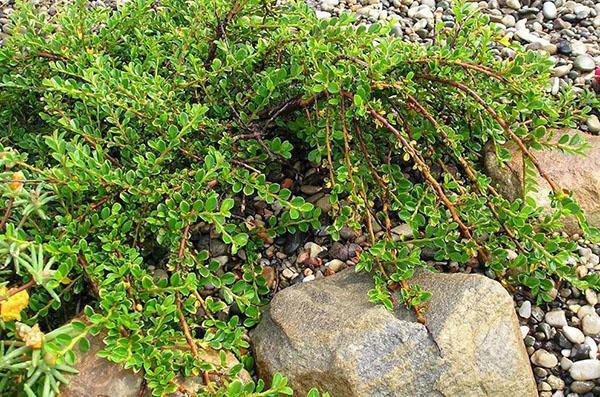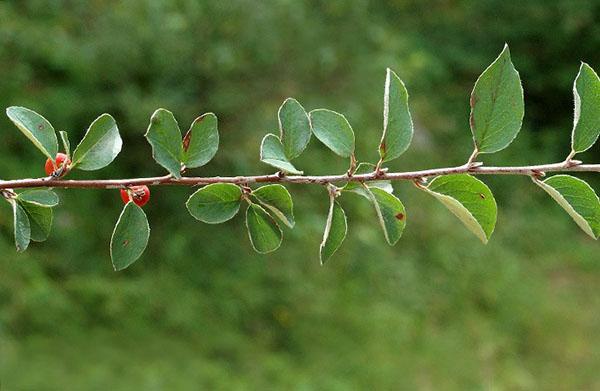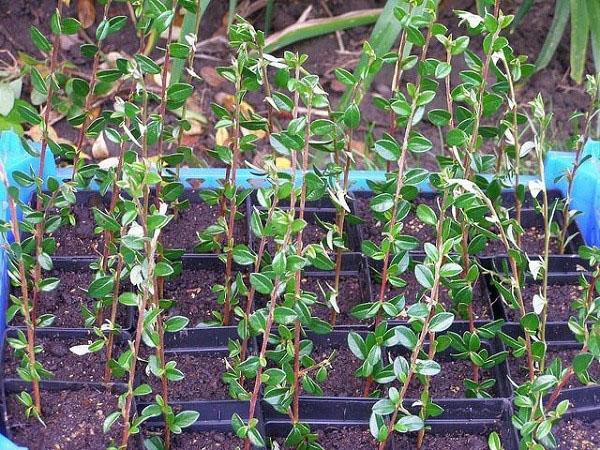Reproduction of cotoneaster: 4 main ways
 Reproduction of a cotoneaster can be carried out in several ways. Each method has its own advantages and characteristics. If you know the basic rules for planting a shrub, then it will develop well, bear fruit abundantly and bring benefit and joy.
Reproduction of a cotoneaster can be carried out in several ways. Each method has its own advantages and characteristics. If you know the basic rules for planting a shrub, then it will develop well, bear fruit abundantly and bring benefit and joy.
Reproduction of cotoneaster by cuttings

For planting, prepare containers filled with a mixture peat with river sand. Cuttings are placed in the soil at an angle. After that it is well watered and greenhouse conditions are created. To do this, just cover the twigs with a jar or part of a plastic bottle. The greenhouse is removed only for a short time for airing, the plants are regularly watered.
 Propagating a cotoneaster by cuttings is quite simple and easy. The plant does not require any special care. Cuttings are planted in open ground only the next year. Since without a strong root system it will be difficult for them to take root in the new conditions.
Propagating a cotoneaster by cuttings is quite simple and easy. The plant does not require any special care. Cuttings are planted in open ground only the next year. Since without a strong root system it will be difficult for them to take root in the new conditions.
When planting cotoneaster cuttings, you need to take care of drainage in the recesses. When water accumulates at the roots, they are quickly affected by rot. If the soil in the area is too acidic, you can neutralize it by mixing in lime.
You can go the other way by cuttings. To do this, in the fall, cut off strong, woody branches. They are stored in cool conditions until spring. You can keep the cuttings right in the refrigerator. Further, the growing procedure is exactly the same. The branches are treated with a root formation stimulator, planted in prepared pits. By the fall, the cuttings will give good roots.
Sowing cotoneaster seeds
 This beautiful shrub bears fruit abundantly with red beaded berries, in which the seeds are hidden. Cotoneaster can be propagated by sowing them, but this is not the most productive method. The seeds germinate very poorly, a significant part does not germinate, and the sprouts themselves slowly grow in growth. To get a seedling of sufficient size, you will have to be patient and wait 3-4 years. Cotoneaster propagation by seeds is more often practiced by breeders engaged in obtaining new plant varieties.
This beautiful shrub bears fruit abundantly with red beaded berries, in which the seeds are hidden. Cotoneaster can be propagated by sowing them, but this is not the most productive method. The seeds germinate very poorly, a significant part does not germinate, and the sprouts themselves slowly grow in growth. To get a seedling of sufficient size, you will have to be patient and wait 3-4 years. Cotoneaster propagation by seeds is more often practiced by breeders engaged in obtaining new plant varieties.
If difficulties do not frighten and there is a desire to try this method, then you need to follow these tips:
- First, the berries wither a little. The pulp is then much easier to separate from the seeds.
- The refined grains are washed to remove it completely.
- Culling of seeds is carried out in order to separate all unpromising specimens at this stage. It is not difficult to do this, it is enough to fill the planting material with water and leave it for a while. Seeds that float on the surface will not sprout, they are immediately thrown away.
- The grains need to be stratified. For two months they are kept at a temperature of 30 ° C, and then it is gradually reduced to -5 ° C.
- The cotoneaster seeds prepared in this way are sown next fall by about 3-5 cm in depth.
 Seedlings should be looked after until spring, then planted in open ground. The cotoneaster tolerates shaded areas well. With sufficient lighting, the decorative features of the plant are fully manifested. Therefore, if possible, it is preferable to plant the cotoneaster in an open area.
Seedlings should be looked after until spring, then planted in open ground. The cotoneaster tolerates shaded areas well. With sufficient lighting, the decorative features of the plant are fully manifested. Therefore, if possible, it is preferable to plant the cotoneaster in an open area.
The hole for planting a plant should be 50x50x50 cm in size. Drainage at the bottom 20 cm high is required so that the roots do not rot. A mixture of peat, humus and sand (all ingredients in 1 volume) and turf (2 volumes) is poured over the drainage. To neutralize the reaction of the soil, you need to mix 250 g lime.
When planting, it is important to leave enough space between the plants: for small varieties, 50 cm is enough, large varieties require about 2 meters.
Division of adult cotoneaster bushes
 If the plant has grown too much, it should be divided into several parts. This procedure can be carried out both in spring and in autumn. The bush is dug up, excess soil is removed, examined and divided into segments with good roots. Each of them is planted separately.
If the plant has grown too much, it should be divided into several parts. This procedure can be carried out both in spring and in autumn. The bush is dug up, excess soil is removed, examined and divided into segments with good roots. Each of them is planted separately.
When planting, the root collar must not be buried; it must be flush with the ground.
After planting, the divided parts are watered daily for the first 3-4 weeks. Then the irrigation is reduced and carried out no more than twice every 30 days. If there is enough natural precipitation, then the culture is watered only once a month. Water consumption for each bush is 7-8 liters.
Reproduction by layering
 This breeding method is suitable for a ground cover cotoneaster. Branches close to the ground can take root on their own and give a new shrub. To speed up this process, young shoots are simply pressed to the ground with staples, lightly sprinkling with humus. By the spring they will give good roots. In April, each specimen can be separated from the mother plant and planted separately.
This breeding method is suitable for a ground cover cotoneaster. Branches close to the ground can take root on their own and give a new shrub. To speed up this process, young shoots are simply pressed to the ground with staples, lightly sprinkling with humus. By the spring they will give good roots. In April, each specimen can be separated from the mother plant and planted separately.
This is a very productive way with 100% results. After all, the branches are still growing their roots are constantly fed from a strong mother bush.
Saplings, when propagated by layering, root well. They are quite strong and have excellent immunity to various diseases.
Regardless of the chosen breeding method bush, do not forget about proper preparation for planting new specimens and good care for them. Young plants are frost-sensitive and require shelter for wintering.